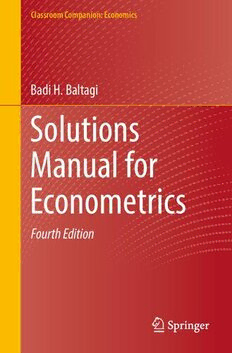Table Of ContentClassroom Companion: Economics
Badi H. Baltagi
Solutions
Manual for
Econometrics
Fourth Edition
Classroom Companion: Economics
The Classroom Companion series in Economics features fundamental textbooks
aimedatintroducingstudentstothecoreconcepts,empiricalmethods,theoriesand
tools of the subject. The books offer a firm foundation for students preparing to
movetowardsadvancedlearning.Eachbookfollowsacleardidacticstructureand
presentseasyadoptionopportunitiesforlecturers.
Badi H. Baltagi
Solutions Manual
for Econometrics
Fourth Edition
BadiH.Baltagi
SyracuseUniversity
Syracuse,NY,USA
ISSN2662-2882 ISSN2662-2890 (electronic)
ClassroomCompanion:Economics
ISBN978-3-030-80157-1 ISBN978-3-030-80158-8 (eBook)
https://doi.org/10.1007/978-3-030-80158-8
©TheEditor(s)(ifapplicable)andTheAuthor(s),underexclusivelicensetoSpringerNatureSwitzerland
AG1997,2010,2015,2022
Thisworkissubjecttocopyright.AllrightsaresolelyandexclusivelylicensedbythePublisher,whether
thewhole orpart ofthematerial isconcerned, specifically therights oftranslation, reprinting, reuse
ofillustrations, recitation, broadcasting, reproductiononmicrofilmsorinanyotherphysicalway,and
transmissionorinformationstorageandretrieval,electronicadaptation,computersoftware,orbysimilar
ordissimilarmethodologynowknownorhereafterdeveloped.
Theuseofgeneraldescriptivenames,registerednames,trademarks,servicemarks,etc.inthispublication
doesnotimply,evenintheabsenceofaspecificstatement,thatsuchnamesareexemptfromtherelevant
protectivelawsandregulationsandthereforefreeforgeneraluse.
Thepublisher,theauthors,andtheeditorsaresafetoassumethattheadviceandinformationinthisbook
arebelievedtobetrueandaccurateatthedateofpublication.Neitherthepublishernortheauthorsor
theeditorsgiveawarranty,expressedorimplied,withrespecttothematerialcontainedhereinorforany
errorsoromissionsthatmayhavebeenmade.Thepublisherremainsneutralwithregardtojurisdictional
claimsinpublishedmapsandinstitutionalaffiliations.
ThisSpringerimprintispublishedbytheregisteredcompanySpringerNatureSwitzerlandAG
Theregisteredcompanyaddressis:Gewerbestrasse11,6330Cham,Switzerland
Preface
This manual provides solutions to selected exercises from each chapter of the
sixth edition of Econometrics by Badi H. Baltagi.1 Eviews and Stata as well as
(cid:2)
SAS programs are provided for the empirical exercises. Some of the problems
and solutionsare obtainedfrom EconometricTheory (ET) and these are reprinted
with the permission of Cambridge University Press. I would like to thank Peter
C.B. Phillips, and past editors of the Problems and Solutions section, Alberto
Holly,Juan Doladoand PaoloParuolofortheirusefulservice tothe econometrics
profession.I wouldalso like tothankmycolleague(fromTexasA&M)JamesM.
Griffinforprovidingmanyempiricalproblemsanddatasets.Ihavealsousedthree
empirical data sets from Lott and Ray (1992). The reader is encouraged to apply
these econometric techniquesto their own data sets and to replicate the results of
published articles. Instructors and students are encouraged to get other data sets
fromtheInternetorjournalsthatprovidebackupdatasetstopublishedarticles.The
JournalofAppliedEconometricsandtheAmericanEconomicReviewaretwosuch
journals.Infact,theJournalofAppliedEconometricshasareplicationsectionfor
whichIservedasaneditorfrom2003–2018.InmycourseIrequiremystudentsto
replicateanempiricalpaper.
I would like to thank my students Wei-Wen Xiong, Ming-Jang Weng, Kiseok
Nam,DongLi, Gustavo Sanchez,LongLiu,Junjie Shu,and LiuTian whosolved
severaloftheexercises.IwouldalsoliketothankMartinaBihn,JohannesGlaeser
andJudithKrippatSpringerfortheircontinuoussupportandprofessionaleditorial
help.
Please report any errors, typos or suggestions to: Badi H. Baltagi, Center for
Policy Research and Department of Economics, Syracuse University, Syracuse,
New York 13244-1020, Telephone (315) 443-1630, Fax (315) 443-1081, or send
[email protected]://pbaltagi.wix.com/badibaltagi.
1Baltagi,BadiH.,Econometrics,6thEd.,Springer-Verlag,Berlin,Heidelberg,2021.
v
vi Preface
Data
The data sets used in this text can be downloaded from the Springer website.
Theaddressis:http://www.springer.com/978-3-642-54547-4.Pleasecheckthelink
“Samples, Supplements, Data Sets” from the right-hand column. There is also a
readmefilethatdescribesthecontentsofeachdatasetanditssource.
Reference
Lott,W.F.andS.Ray(1992),EconometricsProblemsandDataSets(Harcourt,BraceJovanovich:
SanDiego,CA).
Contents
1 WhatisEconometrics?..................................................... 1
2 AReviewofSomeBasicStatisticalConcepts............................ 5
3 SimpleLinearRegression.................................................. 31
4 MultipleRegressionAnalysis.............................................. 49
5 ViolationsoftheClassicalAssumptions.................................. 77
6 DistributedLagsandDynamicModels .................................. 123
7 TheGeneralLinearModel:TheBasics.................................. 153
8 RegressionDiagnosticsandSpecificationTests ......................... 179
9 GeneralizedLeastSquares ................................................ 215
10 SeeminglyUnrelatedRegressions......................................... 235
11 SimultaneousEquationsModel........................................... 261
12 PoolingTime-SeriesofCross-SectionData.............................. 319
13 LimitedDependentVariables ............................................. 347
14 Time-SeriesAnalysis....................................................... 409
vii
1
What is Econometrics?
Thischapteremphasizesthataneconometricianhastobeacompetentmathemati-
cianandstatisticianwhoisaneconomistbytraining.Itistheunificationofstatistics,
economictheoryandmathematicsthatconstituteseconometrics.Eachview point,
by itself is necessary but not sufficient for a real understanding of quantitative
relationsinmoderneconomiclife,seeFrisch(1933).In1969,RagnarFrischshared
thefirstNobelPrizeineconomicswithJanTinbergen.
Econometrics aims at giving empirical content to economic relationships. The
threekeyingredientsareeconomictheory,economicdata,andstatisticalmethods.
Neither ‘theory without measurement’, nor ‘measurement without theory’ are
sufficient for explaining economic phenomena. It is as Frisch emphasized their
unionthatisthekeyforsuccessinthefuturedevelopmentofeconometrics.
Econometrics provides tools for testing economic laws, such as purchasing
power parity,the life cycle hypothesis,the wage curve,etc. These economic laws
orhypothesesaretestablewitheconomicdata.AsHendry(1980)emphasized“The
threegoldenrulesofeconometricsaretest,testandtest.”
Econometricsalso providesquantitativeestimatesof price andincomeelastici-
tiesofdemand,returnstoscaleinproduction,technicalefficiencyincostfunctions,
wageelasticities, etc. Theseareimportantforpolicydecisionmaking.Raisingthe
tax on a pack of cigarettes by 10%, how much will that reduce consumption of
cigarettes?Howmuchwillitgenerateintaxrevenues?Whatistheeffectofraising
minimumwageby$1perhouronunemployment?Whatistheeffectofraisingbeer
taxonmotorvehiclefatality?
Econometrics also provides predictions or forecasts about future interest rates,
unemployment, or GNP growth. As Klein (1971) emphasized: “Econometrics
shouldgiveabaseforeconomicpredictionbeyondexperienceifitistobeuseful.”
LawrenceR.KleinwasawardedtheNobelPrizeineconomicsin1980.
Dataineconomicsarenotgeneratedunderidealexperimentalconditionsasina
physicslaboratory.Thisdatacannotbereplicatedandismostlikelymeasuredwith
error. Most of the time the data collected are not ideal for the economicquestion
©TheAuthor(s),underexclusivelicensetoSpringerNatureSwitzerlandAG2022 1
B.H.Baltagi,SolutionsManualforEconometrics,ClassroomCompanion:
Economics,https://doi.org/10.1007/978-3-030-80158-8_1
2 BadiBaltagi
at hand. Griliches (1986, p. 1466) describes economic data as the world that we
want to explain, and at the same time the source of all our trouble. The data’s
imperfectionsmakesthe econometrician’sjobdifficultandsometimesimpossible,
yettheseimperfectionsarewhatgiveseconometricianstheirlegitimacy.
Eventhougheconomistsareincreasinglygettinginvolvedincollectingtheirdata
and measuringvariablesmore accuratelyand despite the increase in data sets and
datastorageandcomputationalaccuracy,someofthewarningsgivenbyGriliches
(1986,p.1468)arestillvalidtoday:
econometricians want too much from the data and hence tend to be disap-
pointed by the answers, because the data are incomplete and imperfect. In
partitisourfault,theappetitegrowswith eating.Aswegetlargersamples,
wekeepaddingvariablesandexpandingourmodels,untilonthemargin,we
comebacktothesameinsignificancelevels.
Pesaran(1990,pp.25–26)alsosummarizessomeofthelimitationsofeconomet-
rics:
There is no doubt that econometrics is subject to important limitations,
which stem largely from the incompleteness of the economic theory and
the non-experimentalnature of economic data. But these limitations should
not distract us from recognizingthe fundamentalrole that econometricshas
come to play in the development of economics as a scientific discipline. It
may not be possible conclusively to reject economic theories by means of
econometricmethods,butitdoesnotmeanthatnothingusefulcanbelearned
from attempts at testing particular formulations of a given theory against
(possible)rivalalternatives.Similarly,thefactthateconometricmodellingis
inevitablysubjecttotheproblemofspecificationsearchesdoesnotmeanthat
the whole activity is pointless. Econometric models are important tools for
forecastingandpolicyanalysis,anditisunlikelythattheywillbediscardedin
thefuture.Thechallengeistorecognizetheirlimitationsandtoworktowards
turningthemintomorereliableandeffectivetools.Thereseemtobenoviable
alternatives.
Econometricshaveexperiencedphenomenalgrowthinthepast60years.There
are six volumes of the Handbook of Econometrics, most of it dealing with post
1960sresearch.Alotoftherecentgrowthreflectstherapidadvancesincomputing
technology. The broad availability of micro data bases is a major advance which
facilitatedthe growthofpaneldata methods(see Chap.12)andmicroeconometric
methodsespeciallyonsampleselectionanddiscretechoice(seeChap.13)andthat
also lead to the award of the Nobel Prize in Economics to James Heckman and
Daniel McFadden in 2000. The explosion in research in time series econometrics
which lead to the development of ARCH and GARCH and cointegration (see
Chap.14) which also lead to the award of the Nobel Prize in Economicsto Clive
GrangerandRobertEnglein2003.

